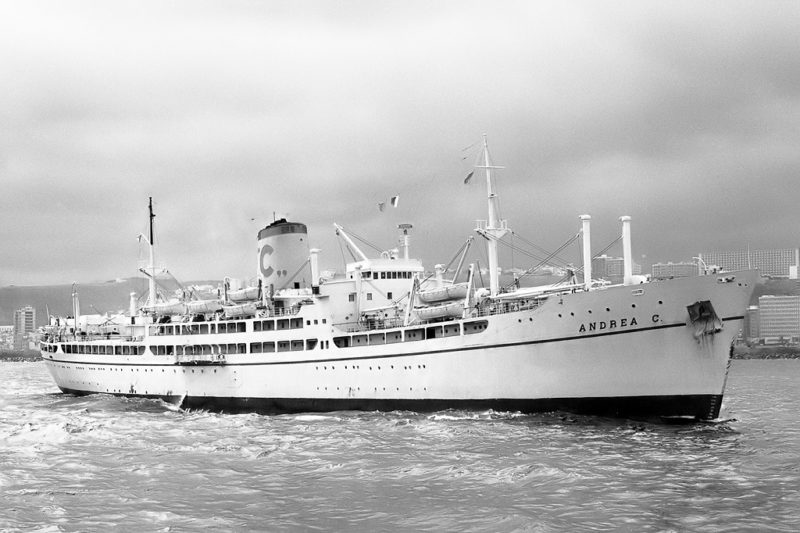
The classic hull styling and raked funnel of the Costa Line flagship Federico C of 20,416 gross tonnes gave her the lines of a very attractive liner when she entered service in March 1958 on the Italy to North America and South America routes. She served Costa Line for 25 years and continued in service for two other cruise lines to give a total of 42 years in service before she suffered a suspicious ending to her career in December 2000.
Costa Line was founded in 1860 by Giacomo Costa aged 24 years as ‘Giacomo Costa fu Andrea’ running an edible oil business in Genoa, and he also operated general cargo ships for several decades after 1924 carrying cargoes of olive oil, textiles, timber and coal. The company passed to the three sons of the founder in 1924 in Federico, Eugenio and Enrico Costa.
The company began shipping operations with the old steamer Ravenna of 1,148 grt built back in 1888, followed by the steamers Federico of 1,488 grt and Langano of 1,245 grt in 1928, with six more coastal ships added to the fleet by 1939, a number of these becoming war losses. The trio of brothers were operating from premises in Vittorio Emmanuelle Street in Genoa. Three larger cargo ships of up to 10,000 dwt that dated from during or just after World War I, were purchased in 1947 from the American owned Luckenbach Line and were renamed Maria C, Giovanna C and Luisa C. They were given good accommodation for 25 passengers on their regular liner service between Genoa and Montevideo and Buenos Aires in 1947, before transferring to a Genoa to Philadelphia, Baltimore and New York service a year later. They were broken up in the 1950s and the company then concentrated on providing better and larger emigrant passenger services.
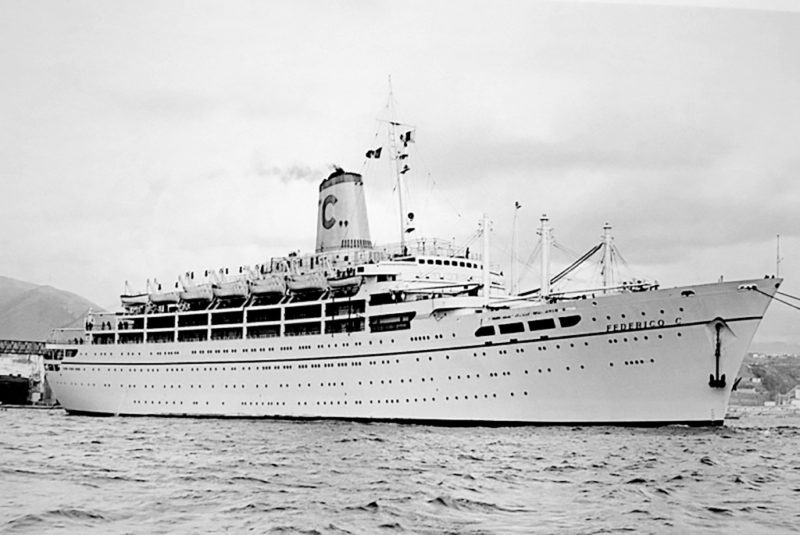
PASSENGER SHIPS OF COSTA LINE
One of the quartet of ‘Compass Point’ liners of Prince Line of Newcastle upon Tyne, Southern Prince of 10,917 grt and built by the Lithgow yard at Port Glasgow in 1929 for the New York to Buenos Aires run, was purchased in 1947, rebuilt and refitted until 1948, and renamed Anna C. The passenger accommodation was increased from 120 to 164 First Class and Second Class passengers and around 800 emigrants, and she ran to Montevideo and Buenos Aires from 31st March 1948 along with another war built passenger and emigrant ship conversion, Andrea C, previously Ocean Virtue of the standard 60 ship ‘Ocean’ class of general cargo ships. Andrea C was given emigrant passenger capacity for 200 people, with the two emigrant liners taking the place of the three previous Luckenbach Line ships. Anna C was sold for breaking up at Savona in 1972, and Andrea C later became a cruise ship and was still in service in 1982 for other owners when she was broken up.
Roma of 6,822 grt was purchased by Costa Line in 1951 and renamed Franca C. She had a very long history having been built back in 1914 by the Newport News Shipbuilding & Dry Dock Company for Mallory Lines of New York on a pioneer Eastern Seaboard service.
She was rebuilt at La Spezia in 1949 for Italian owners and able to carry 925 emigrants on the Genoa to Buenos Aires run. In 1968, she was again a pioneer, this time offering air/sea packages in the Caribbean out of San Juan in Puerto Rico. She was re-engined again with diesel engines in 1970 before starting another long career as the Maltese registered Doulos library ship for ‘Good Books for All’ in 1977.
The Rotterdam Lloyd liner Indrapoera of 9,585 grt, built at Flushing in 1925 by the Royal De Schelde yard, was purchased in 1957 and renamed Bianca C after a daughter of the Costa family with emigrant passenger accommodation for 400 passengers. She ran for a year to Montevideo and Buenos Aires from Genoa until sold in 1958 to Messageries Maritimes of France and renamed Melanesian for passenger services to the South Pacific until broken up in 1962 in Italy after a 37 year career. Bianca C (2) of 1949 was the former Messageries Maritimes of France flagship La Marseillaise and purchased by Costa Line in 1959. She sailed from Genoa on 12th October 1961 on her last voyage and anchored off St. George’s, the capital of Grenada. An explosion and fire in her boiler room crippled her with two dead and a dozen crew badly burnt, she was towed to a point further from the harbour where she sank.
Fulvia was the former Oslofjord flagship of Norwegian America Line of 1949 when purchased by Costa Line in 1969, but a year later on 19th July 1970 she caught fire near the Canary Islands. The passengers were evacuated and she sank during the following day while being towed to Tenerife.
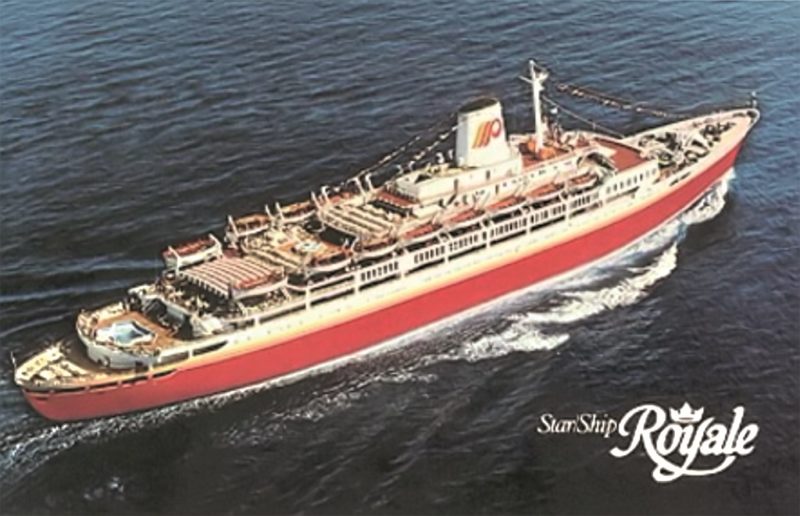
THE STYLISH PURPOSE-BUILT FEDERICO C
She was completed as a three class liner with accommodation for 264 passengers in First Class, 202 in Cabin Class, and 672 in Tourist Class with a crew of 270. She was launched on 31st March 1957 by the Ansaldo yard at Sestri Ponente near Genoa, the oldest shipbuilding yard in Italy dating from 1853, and completed in February 1958, making her maiden voyage to Buenos Aires on 22nd March 1958 from Genoa. Costa Line began in the cruising business by offering a few Mediterranean cruises in 1959 and later in the Caribbean. There was a decline in passenger and emigrant services to South America in the early 1960s due to air travel, and Federico C was the new, superior, high quality passenger ship to continue First Class and Second Class services to Montevideo and Buenos Aires.
The launch of this memorable liner, Yard number 1516, had been attended by many personalities including the Italian Minister of the Merchant Marine as well as the Archbishop of Genoa, with Miss Franca Costa, daughter of Mr. Angelo Costa, as the sponsor. After launching she was towed to the Ansaldo yard fitting-out quay where her interiors were fitted by some of the finest Italian interior decorators for her First Class Lounge and staterooms. She completed three days of trials in late February 1958 with a top speed over the measured mile of 22.3 knots, and was then dry-docked to receive her final touch-up painting before delivery to Costa Line.
Federico C was given a flared bow, adequate sheer, cruiser stern, and a modern motor ship funnel of yellow with a blue stylised “C” and a blue top behind her navigating mast. She had an all white hull livery with a blue hull ribbon and was a very attractive ship indeed. She had dimensions of overall length of 605.0 feet (184.61 metres), moulded beam of 79.0 feet (24.06 metres), and a loaded draft of 28.2 feet (8.846 metres), with two sets of derricks of ten tonnes capacity on small pole masts to serve her three forward holds, and also four small cranes of two tonnes capacity to serve her aft three holds. She had a fo’c’stle of length 22.3 metres, bridge deck length of one hundred metres, refrigerated space capacity of 86,300 cubic feet, and a rivetted and welded hull of five decks.
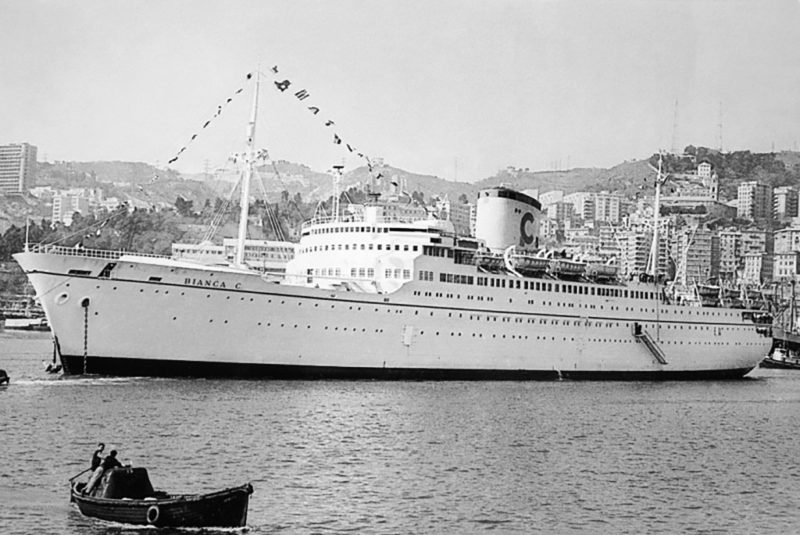
Federico C was powered by four De Laval geared steam turbines with steam raised by three watertube boilers and developing a combined 28,600 shp to give a top speed of 23 knots and a service or cruising speed of 21 knots. She was a twin screw ship and had a bunker capacity of 3,962 tonnes of fuel oil and 250 tonnes of diesel oil with a fuel oil consumption of 145 tonnes per day. She had four diesel generators for electricity production, and carried 2,076 tonnes of water ballast. She had 424 cabins for 1,138 passengers in three classes, and eight beautifully decorated passenger decks as follows:-
Bridge Deck
The forward navigating bridge had the Master’s and officer’s quarters to the rear on port and starboard sides, and aft was the Radio Room and Children’s Playroom, and a spacious sports deck at the end of the deck.
Sun Deck
A range of First Class cabins forward and along the whole starboard side of the superstructure, while aft was the attractive First Class Pool Lounge with a café, with a spacious open deck and the First Class swimming pool. Seven lifeboats were carried to port and starboard, making a total of fourteen boats, two of them having engines.
Lounge Deck
The large First Class Ballroom forward was decorated with attractive murals of ladies in their best dancing dresses, and was followed by the Lobby and two grand stairwells and two lifts, and then the First Class Main Lounge, Bar, Library and Reading Room. The open First Class Promenade space to port and starboard stretched half way along the deck, with the Cabin Class promenading space along the aft part until the Cabin Class Pool Lounge and swimming pool were reached near the stern. The First Class Main Lounge featured a horizontal wall sculpture of a bronze flute player by Marcello Mascherini, while ‘midships was the Cabin Class Lobby that was followed by the huge Venezia Lounge, again decorated with many wall murals. Yellow and red coloured sofas and easy chairs, and glass topped tables were distributed all along Lounge Deck. Cabin Class public rooms were almost the same in quality of furnishings as First Class.
Promenade Deck
Many First Class staterooms from forward to ‘midships with a fine interior lobby, and then Cabin Class staterooms from ‘midships to the stern, promenading space to port and starboard for both classes. The Tourist Class Lounge aft looked out over the Tourist Class swimming pool.
Restaurant Deck
The forward large Cinema was followed by some First Class outside cabins, each suitably furnished with a double dressing table and mirrors, with fresh flowers on boarding, together with shower and toilet. An outside Cabin Class stateroom had less space than a First Class cabin but featured the same double dressing table and mirrors, with blue and yellow shower curtains, and in some cases were interchangeable with First Class cabins. The cinema was followed by the Main Lobby with a purser’s office, followed by a very large Restaurant, which was divided into two areas, forward for First Class and aft for Cabin Class. The dining facilities for both classes had much the same space and décor, and the Dining Room was equivalent to any other luxury liner of the late 1950s. The aft section of this deck had outside Cabin Class staterooms to port and starboard.
Main Deck
Tourist Class cabins filled the forward section as well as several small public rooms before reaching the large deck wide Tourist Class Restaurant. More Cabin Class and Tourist Class cabins in the aft part of this deck before the deck wide Firenze Lounge for Cabin Class and the Orvieto Lounge for Tourist Class was reached. The bar in the Orvieto Lounge had a long horizontal mirror so that passengers could see themselves sitting on bar stools, with a long and beautiful wooden top and sides to the bar. The Orvieto Lounge had red easy chairs, while Firenze Lounge was further aft with yellow and blue easy chairs with interesting wall mural decorations.
‘A’ and ‘B’ Decks
These two lower decks contained both Cabin Class and Tourist Class cabins, together with other facilities e.g. the Doctor’s surgery and waiting room. ‘B’ Deck only had cabins in the forward part of the deck with crew cabins aft, and crew cabins also on the port side of ‘A’ deck. A two berth Tourist Class cabin had bunk beds, one above the other, with a dressing table, mirror and comfortable chairs. A four berth Tourist Class cabin had two sets of bunk beds opposite each other at the sides of the cabin, with two sets of dressing tables, and blue, white and yellow curtains concealing the shower for privacy, with the room furnished with comfortable chairs and a bowl of fresh flowers on boarding.
Federico C sailed on her maiden voyage from Genoa on 23rd March 1958 to Rio de Janeiro, Santos, Montevideo and Buenos Aires with calls at Naples, Cannes, Barcelona and Funchal on Madeira. She would occasionally call also at Recife and Bahia in Brazil, and became a very popular ship with a loyal clientele and was often fully booked with passengers. The famous Polish writer and playwright Witold Gombrowicz travelled from Buenos Aires to Europe on Federico C in 1963. He had left his home country 24 years earlier onboard the motor passenger liner Chrobry of 11,500 grt of Polish Ocean Lines, having been invited to take part in the maiden voyage of the latest addition to the Polish flotilla of liners. British passengers and those who admired from onshore were only able to board or see the ship once during her long career on a brief visit at Southampton.
The arrival of the stylish twin funnelled aft Eugenio C of 30,567 grt in 1966 from the Adriatico yard in Monfalcone with accommodation for 1,750 passengers as the new Costa Line flagship meant Federico C transferred to a new Caribbean service. She operated this sunny Caribbean route from June to December each year, which could be taken either way or as a complete round voyage. She cruised in winter from Genoa on Mediterranean ports, or from Northern European ports to the Baltic and North Cape of Norway.
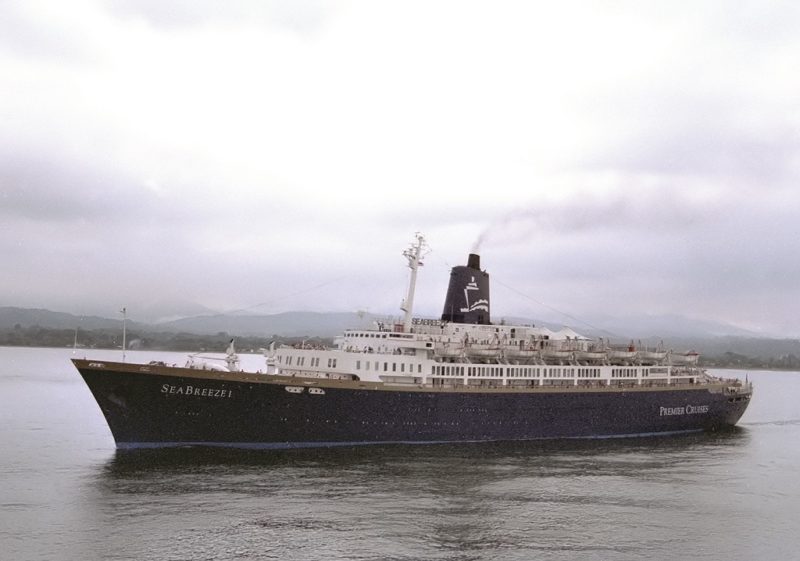
1966 SAILING SCHEDULE
Federico C spent January of each year on short Mediterranean cruises from Genoa, then entered dry-dock at her home port in early February for two weeks of annual overhaul and repainting of paintwork. The crew rejoined in mid February to replenish all of her essential stores before she was ready to restart her busy sailing schedule on liner voyages and cruising.
In 1967 after ten years in service, Federico C was given a thorough refit with upgraded facilities and better cabins for the more demanding passengers of the late 1960s. She was sent to the Mariotti yard in Genoa, with work starting in May 1968 on external and internal changes to make her a part-time liner in summer and a cruise ship in winter in the Northern Hemisphere. She had a new two class configuration of First Class (186 passengers) and Tourist Class (1,450 passengers), with 1,250 passengers in one class when operating as a cruise liner. The Promenade Deck was glazed in as far as the last two lifeboats on Boat Deck, and the forward number three hold was removed together with its derricks.
Costa Lines had a fleet of seven passenger and cruise ships in 1970, with only the purpose-built flagship Eugenio C of 1966 and the Tyne-built Enrico C, built in 1950 as the French liner Provence, on the Italy to South America liner passenger service. Enrico C was converted to a full-time cruise ship in 1972, leaving the flagship with her much greater speed of 28 knots to continue the South American service for part of the year until the early 1980s. The other Costa Lines cruise ships in 1970 were Flavia, the former Cunarder Media built in 1947 and engaged on three day and four day cruises from Miami to the Bahamas after purchase in 1969, and Carla C, the former Flandre of French Line built in 1952, and chartered out to Princess Cruises at that time.
The schedule of Federico C was gradually altered by 1972 to include more Caribbean cruises from Fort Lauderdale, and from June of that year she became a full-time cruise liner. She operated ten day and eleven day Caribbean cruises from Fort Lauderdale to Montego Bay, Panama, Cartagena, Aruba, Curacao and St. Lucia. The sparkling blue seas and climate of the Caribbean, combined with the attentive all Italian crew and stewards, who knew how to give every luxury to their discerning American passengers, made successful cruising. Spacious one class staterooms, elegance of her public rooms, and the graciousness of the officers and stewards won over the passengers, and she continued cruising for Costa Line for the next eleven years until 1983. During the winter of 1976 and 1977, there were further upgrades to her interiors, then in September 1980 she was fully refurbished to make her an even more popular Italian cruise ship.
Expansion was the keynote of Costa Lines in 1974 with the purchase of the purpose-designed cruise ship Italia. Two former Port Line cargo-liners, which had been converted to cruise ships in 1975/76 by Carras of Greece, were leased by Costa Lines in 1979 as Daphne and Danae. The former Hapag-Lloyd cruise flagship Europa, built as Kungsholm in 1953 for Swedish America Line, was sold to Costa Lines in 1981 and renamed Columbus C after a new cruise liner Europa (2) had been delivered to Hapag-Lloyd.
In 1981, Costa Cruises had a large fleet of eight full-time cruise ships, and was second only to the Soviets in size of fleet, which was:-
- The flagship Eugenio Costa, renamed from Eugenio C, cruised mostly in the Eastern Mediterranean
- Enrico Costa and Columbus C cruised mostly to the Western Mediterranean islands
- Carla Costa was cruising all year round from San Juan to St. Thomas and other Caribbean islands
- Flavia cruised from Miami to Nassau
- Daphne wintered in the Caribbean islands and summered in Alaska, and her sister Danae operated Mediterranean cruises plus a Round the World cruise lasting four months
- The purpose-built Italia of 1967 included Straits of Magellan cruises in her wide-ranging busy schedule
The Costa Line cruise ship fleet in 1983 was beginning to expand again, and was composed of the flagship of Costa Riviera, the former Guglielmo Marconi of Lloyd Triestino built in 1962, Eugenio C, Federico C, Enrico C, the former Provence built in 1950 on the Tyne for SGTM of France, Carla C, the former Flandre built in 1952, as well as the converted cruise liners, Danae and Daphne, both former Port Line cargo-liners.
When Federico C returned to Genoa on 22nd October 1983 from a Mediterranean cruise, the decision was made by Costa Line to withdraw her from cruising and send her into lay-up pending her sale after 25 years of excellent service to the Italian company.
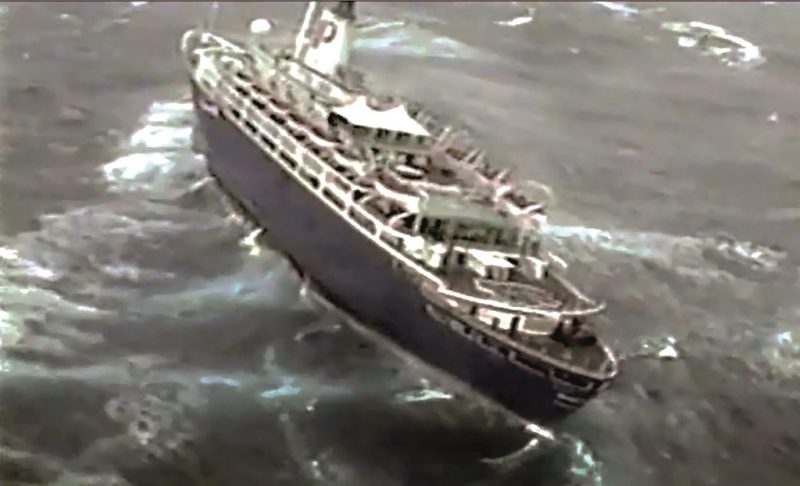
STARSHIP ROYALE
Federico C was sold on 29th November 1983 to Premier Cruise Lines based at Port Canaveral near Cape Canaveral in Florida and renamed Royale. The new owners sent her to the Mariotti yard in Genoa, where all her decks were renamed, with her hull painted red and her funnel painted white with a large ‘P’ logo in red, orange and yellow. This extensive refit cost $14 million under the supervision of A. & M. Katzourakis, with the intention to recoup this money on cruises from the mid Florida port of Port Canaveral, and not in competition with many other cruise lines operating from Miami and Fort Lauderdale. She began cruising for Premier Cruise Line on 26th March 1984 as a full-time cruise ship offering three day and four day Caribbean cruises and marketed as ‘Starship Royale’.
The Greyhound Bus and Tour Corporation of the U.S.A. had been instrumental in financing the purchase of Federico C, and were very famous for their Greyhound coach travel linking all of the major cities of the U.S.A., and had long wanted an entry into the Florida cruise market. They invited Bruce Nierenberg to be the Executive Vice President of Premier Cruise Lines, as he had been a pioneer of the fly/cruise market for Norwegian Caribbean Line (NCL) in the late 1960s and early 1970s. This allied cruise ships with airlines to expand the cruise passenger potential from a predominantly Florida clientele to one with Northern American, Canadian and European passengers. Port Canaveral had recently opened a new $3.5 million cruise terminal to attract passengers to the mid Florida Walt Disney World, Epcot Centre at Orlando, and other nearby major tourist attractions. Bruce Nierenberg was ably assisted by Bjonar Hermansen, both former NCL marketing personnel.
Royale was renamed Starship Royale in 1985 to further attract passengers, who had seen the Starship Enterprise space odyssey on television, and who could now dance in the Outer Limits Disco, lounge in the Club Universe, dine in the Galaxy Dining Room, be entertained in the Starlight Cabaret, and enjoy the Mars Bar, all with space and planet decoration themes. The profits of Premier Cruise Lines also sky rocketed as the ship was fully booked to capacity. Premier Cruise Lines expanded by purchasing two further cruise liners, firstly the engines aft Oceanic from Home Lines in 1985 for $20 million, having been built in 1965 by Cantieri Riuniti dell ‘Adriatico at Monfalcone and renamed Starship Oceanic, and secondly Atlantic, built at La Seyne in France in 1981, and leased by Premier Cruise Lines in early 1988 and renamed Starship Atlantic. Holland America Line had purchased Home Lines with this pair of liners, but felt that it could not use the smaller Atlantic on its own services.
In 1988, Premier Cruise Lines purchased Sun Princess from P. & O. Cruises, the former Spirit of London built in 1971, and she was renamed Starship Majestic for cruises out of Key West. She had been built by CN del Tirreno & Riuniti yard at Riva Trigoso, located mid-way between Genoa and La Spezia on the Ligurian coast of Italy, and a sister of Southward launched on 5th June 1971 for Norwegian Caribbean Line (NCL) of Knut Kloster. Starship Majestic was chartered for four years in 1994 to become the flagship in Europe of CTC Cruises under the name of Southern Cross. She was then sold to Festival Cruises in 1996, with Starship Atlantic following to Mediterranean Shipping Cruises (MSC) shortly afterwards for $70 million.

Premier Cruise Lines sold Starship Royale to Greek principals of the Vlassopoulos family running Dolphin Cruise Line, founded in 1984 with finance via Ulysses Shipping S. A. of Greece. The latter company had purchased in 1973 the liner Southern Cross of 1955 from Shaw, Savill & Albion Co. of London and had her converted for cruising out of Piraeus as Calypso. She was then sold to Gotaa-Larsen in 1980 but repurchased by Dolphin Cruise Line in 1991 as Ocean Breeze. Peter Bulgarides and Paris Katsoufis were in charge of marketing the Dolphin Cruise Line, and linked Walt Disney World visits to cruise packages with great success in the same way as Premier Cruise Lines.
The main Dolphin Cruise Line ship was the former Zion of 12,091 grt and built in 1956 for Zim Line of Israel and renamed Dolphin IV with accommodation for 562 passengers. She had only minor exterior alterations from her 1956 profile when cruising from Miami, and berthed in close proximity to the much larger cruise ships of Royal Caribbean Cruise Line (RCCL). Dolphin IV was still in service in 1996 after being sold by Dolphin Cruise Line to Canaveral Cruises for operations also out of Port Canaveral, and linked via a charter to Majesty Cruise Line of Greece.
Starship Royale was delivered to Dolphin Cruise Line on 2nd January 1989 and renamed SeaBreeze 1. She received another refit with her hull painted white again and with three blue hull stripes, tapering downwards at the bow, and her funnel now had a jumping dolphin logo. The nine decks of SeaBreeze 1 were then renamed as follows:-
- Aida Deck
- Navigating Bridge forward, Master and Officers accommodation, The Planets Lounge aft.
- La Boheme Deck
- Four Seasons Observatory forward, port and starboard outside staterooms and cabins, Prelude Lounge with bar and cane tables and chairs and a grand piano, whirlpool and open deck space aft.
- Carmen Deck
- Royale Lounge forward, Hemingway Room, Surprise Lounge and Casino, Shopping Arcade and La Boutique shop, extensive Carmen Lounge ‘midships, and a relaxing raised Café and open deck space aft.
- Daphne Deck
- Jogging track forward, Alegra shop, port and starboard outside staterooms and cabins, Gymnasium Centre and Serenade Lounge aft overlooking the Le Mar swimming pool.
- Electra Deck
- Jogging Track forward, port and starboard staterooms and cabins, Partner’s Meeting Square, full deck width Electra Lounge with Bacchanalia Lounge in green and blue décor and Bacchus Wine Cellar at rear with music played on a grand piano, further port and starboard staterooms and cabins, children’s playroom, and a bar aft with an open recreational area.
- Fidelio Deck
- Figaro Beauty Salon and Massage Parlour forward, port and starboard outside staterooms and cabins, economy inside central cabins.
- La Gioconda Deck
- Passenger staterooms and cabins to starboard for the full length of the deck, with crew accommodation to port, and also Doctor’s surgery, waiting room and hospital ‘midships on port side.
- Isolde Deck
- Passenger staterooms and cabins to starboard and port with economy inside central cabins.
- Juliet Deck
- Juliet Disco and Bar.
SeaBreeze 1 had eight types of staterooms and cabins, with a fare structure per person based on double occupancy in 1999 on 7-Night Mayan cruises from Fort Lauderdale to Cozumel, Roatan (Honduras), Belize City, and Key West, 2-night Boston cruises to nowhere, and 5-night Canadian cruises from Boston to Halifax (NS), St. John (NB) and Portland (Maine) as follows:-
Cabin Description. 7-Night 2-Night 5-Night
De-Luxe Suite $2,259 $649 $1,429
Luxury Suite $2,158 $549 $1,279
De-Luxe Oceanview $1,559 $489 $1,099
Luxury Oceanview $1,459 $469 $1,049
Oceanview $1,359 $449 $1,009
De-Luxe Inside $1,259 $409 $939
Inside Twin Bed $1,159 $389 $819
Economy $1,059 $309 $689
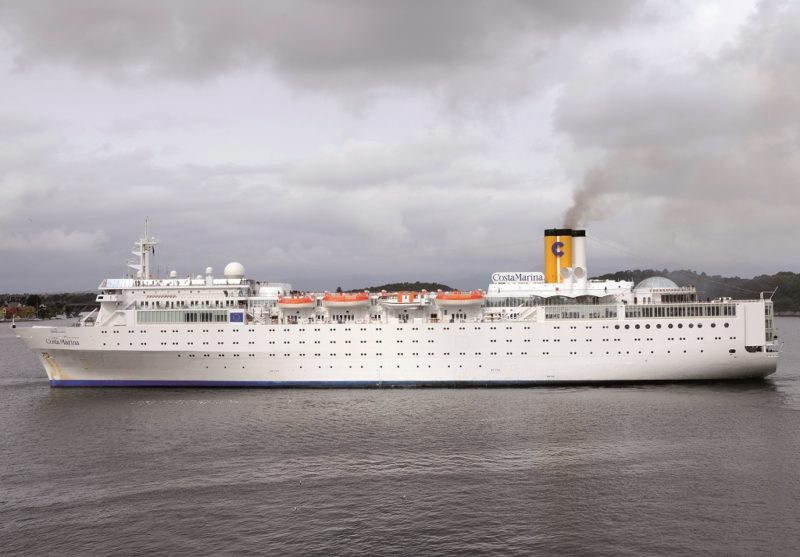
FEDERICO C FINALE
Premier Cruise Lines, based in Challenger Road in Cape Canaveral, had a fleet of five cruise liners at the end of 1998 in SeaBreeze 1, repainted with a dark blue hull with gold accents and a dark blue funnel with white logo, Island Breeze, the former Transvaal Castle and Festivale of 1961, Ocean Breeze of 1955 the former Southern Cross and Azure Seas, Rembrandt the former Holland America Line Rotterdam of 1959, and Starship Oceanic of 1965. The Chief Executive Officer of Premier Cruise Lines at this time was Jim Naik, with Vice President (Marine Operations) in Harry Psimarnos, and Vice President (Sales) in Gary Sain. Premier Cruise Lines very sadly went out of business in early September 2000, and the ship was prevented from sailing with passengers from Halifax (NS), with passengers disembarked without any warning half way through their cruise and the ship laid-up on 14th September 2000. A week later, Seabreeze 1 headed south to a more permanent lay-up berth at Freeport in the Bahamas. She returned to Halifax (NS) in December 2000, and sailed from there on 15th December 2000 with only 34 crew members onboard for Charleston (SC).
Her sinking caused international headlines and concern, as there were a number of allegedly suspicious factors, including the fact that the cruise ship was insured for $20 million but her scrap value was put at only between $5 million and $6 million, and the fact that her Master radioed the U.S. Coastguard for a helicopter evacuation of the crew moments after a ‘Mayday’ distress call was sent out saying that engine room was flooding with high winds and 7.6 metre waves in the vicinity instead of requesting salvage tugs to try and tow her to shore. Photographs of the ship taken from the rescuing helicopter showed that she was riding the waves well on an even keel and completely upright. She sank in international waters 220 miles from the coastline of the U.S.A. flying the Panamanian flag, thus making the Republic of Panama responsible for the investigation into the sinking. If the sinking had taken place within the 200 mile U.S.A. territorial waters limits, then the investigation would have been under the more thorough jurisdiction of a U.S.A. investigation.
The attractive Federico C had sailed on liner and cruise voyages for 42 years, and may have lasted even longer if her last voyage had not been under allegedly very suspicious circumstances. The cruise ship had just been purchased before her final voyage by Cruise Ventures III, a subsidiary of New York based DLJ Capital Funding.
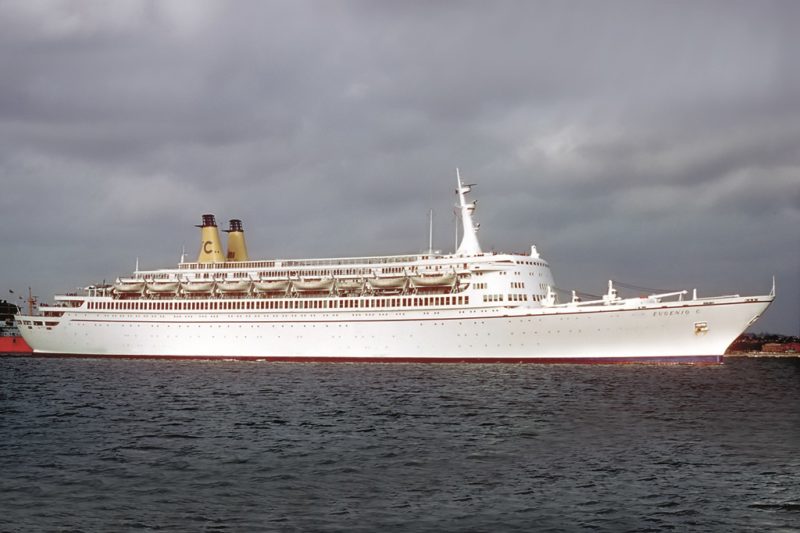
COSTA CRUISES FLEET DURING THE LAST THREE DECADES
In 1990, the first of two former converted Johnson Line container ships entered service for Costa Cruises with glazed observation decks at their cutaway sterns and clustered stove pipe yellow funnels. This was Costa Marina with accommodation for 1,050 passengers, and she was followed in late 1992 by her sister Costa Allegra. The seven ship fleet also included Eugenio Costa, Daphne, Danae, Enrico Costa, and Costa Riviera, the former Lloyd Triestino liner of 1963. The new Costa Classica of 1991 and her sister Costa Romantica of 1993 from Fincantieri yards in Italy had accommodation for 1,766 passengers.
Costa Cruises was forced to close down its Far East subsidiary of Pearl Cruises during 1996 due to huge and mounting losses from its cruises out of Hong Kong, Singapore and Yokohama. This subsidiary had been set up by Lauritzen Lines of Denmark using Pearl of Scandinavia, built as the Baltic ferry Finlandia in 1967, which was then used for Cuban cruises out of Havana as Costa Playa.
The former Costa Cruises flagship Eugenio Costa was withdrawn from service at the end of 1996 and sold off, together with Daphne sold to Swiss Leisure Cruises as Switzerland, her sister Danae having been sold off in 1992. Costa Cruises was the market leader in Mediterranean cruises at the end of 1996 and thus attracted interest from bigger cruise lines in possible take-over bids. Carnival Cruises of Miami and Airtours submitted a joint bid of $301 million in early 1998, which was accepted by the Italian Costa family.
The 1998 Costa Cruises programme featured the following cruises:-
The big cruise ships of Costa Victoria, Costa Romantica and Costa Classica sailed on a total of 57 winter Caribbean cruises of nine day duration from Fort Lauderdale and from the French island of Guadeloupe. This trio then joined three other Costa Cruises ships in April for Mediterranean cruises as the market leader.
Costa Playa was engaged on year round Cuban cruises out of Havana
Costa Allegra and Costa Marina were engaged on a summer programme of Norwegian fjords, North Cape of Norway and Baltic cruises.
The takeover of Costa Crociere by Carnival Cruises of Miami in early 1998 began the ordering of a long series of identical sister ships of 82,000 gt or bigger for Carnival Cruises and for the subsidiaries of Costa Crociere, Holland America Line, and later for P. & O. Cruises and Cunard Line.
The fleet in Millennium year was one of eight cruise ships in Costa Classica (2000), Costa Allegra (1969), Costa Marina (1969), Costa Classica (1991), Costa Riviera (1962), Costa Romantica (1993), Costa Playa (1967) and Costa Victoria (1996).
Costa Marina and Costa Allegra were much smaller cruise ships compared to these giants, and were then based for the traditional South American cruise market in Rio de Janeiro, Santos and Buenos Aires instead of Caribbean cruises. Costa Allegra was forced to cut short her South American programme by six months in 2002 due to Argentinean financial problems, and she returned to Genoa. The pair continued their summer cruising seasons with seven night cruises from Amsterdam and Copenhagen. Costa Marina made some seven night Western Mediterranean cruises in late Autumn of Millennium year before cruising from South America, while near sister Costa Allegra was engaged on seven night Eastern Mediterranean cruises to Piraeus, Rhodes, Limassol and Alexandria before also cruising from South America.
The pattern of Northern Capitals, Baltic and North Cape cruises in summer from Amsterdam (Costa Allegra) and Copenhagen (Costa Marina), and then transfer to the South American market was repeated during the next five years to 2005. After a $12 million refurbishment at the Mariotti yard, Costa Allegra was relocated to cruising out of China in June 2006, with her interiors completely refurbished to better suit the Chinese taste. She cruised on five night cruises from Shanghai to Nagasaki in Japan, and Cheju in South Korea, with longer cruises to the Philippines, Malaysia, Viet Nam, Thailand and around the Indonesian islands. Costa Classica and Costa Romantica replaced her on these Far Eastern cruises in 2010, and Costa Allegra was transferred back to the Mediterranean to cruise in the French market from Marseille for Paquet Cruises, which had obtained a 23% shareholding in Costa Crociere at the end of 1992. She was marketed as Allegra although her name did not change, and she made four Spring cruises and seven Autumn cruises from Marseille in 2010. She retained most of her crew for these French cruises, but was given a French Master, French chefs, French cruise director and French maitres de maison to better suit the French taste.
The Costa Cruises fleet in 2006 was one of eleven cruise ships in Costa Allegra (1969), Costa Atlantica (2000), Costa Classica (1991), Costa Concordia (2006), Costa Europa (1986), Costa Fortuna (2003), Costa Magica (2004), Costa Marina (1969), Costa Mediterranea (2003), Costa Romantica (1993) and Costa Victoria (1996).
The disaster of the loss of the much larger Costa Concordia on 13th January 2012 due to the fault of her Master coming too close to rocks on Isola del Giglio island in the Strait of Argentario just off the western coast of Tuscany on a ‘wave by’ to friends onshore. Some 4,200 people were rescued, but very sadly 32 people died.
This was followed six weeks later on 27th February 2012 by a fire in the generator room of Costa Allegra. She was left without power and adrift two hundred miles to the south west of the Seychelles. She was on a cruise from her winter base of Mauritius, and had sailed from Diego Suarez on Madagascar on a three day passage to Mahe. She was then towed slowly by a French tuna trawler into Mahe, the biggest town and capital of the Seychelles group of islands. Passengers were forced to remain near the swimming pools to keep cool during the day, and to sleep outside on deck wrapped in blankets at night. The toilets quickly became blocked, and with only bread and salami to eat, helicopters arrived bringing food supplies. A total of 1,049 people were on board, comprising 636 passengers and 413 crew members, and they were relieved to be back on dry land after their ordeal of several days on a cruise ship without power. Some passengers suffered broken limbs, and all were exhausted on reaching Mahe, with every hotel in the group of islands having to accommodate this huge number of guests.
Costa Crociere announced that Costa Voyager was to take over the cruise programme of Costa Allegra until July 2012. A survey of the damage revealed extensive damage with repairs being too expensive, and Costa Allegra was sold to Themis Maritime and renamed Santa Cruise. She was then beached at the scrap yard at Aliaga in Turkey in December 2012 for breaking up after a cruise career of twenty years. She had been registered in seven countries during her long 43 year career as a container ship and a cruise ship.
Costa Marina was completely refurbished in 2002 to continue her summer cruising programme from Copenhagen, and was dedicated to the German passenger market for several years. She made six cruises of 14 nights duration based at Mauritius in the Indian Ocean from December 2007 to March 2008 to South Africa, Madagascar and northwards to the Red Sea.
However, on 3rd August 2011 Carnival Cruise Corporation, her owners, announced that a new much larger cruise ship was to be built for Costa Crociere, and that Costa Marina would be withdrawn in November 2011. Grand Voyager, one of the Spanish Iberocruceros cruise ships, also owned by Carnival Cruise Corporation, took over her forward cruising programme in the Indian Ocean and Red Sea. Costa Marina was sold in November 2011 to Harmony Cruises of South Korea and was en-route there in the same month to be renamed Harmony Cruise, and her registry was changed to the Marshall Islands.
However, after a single season she was laid up, and two years later she arrived in September 2014 at the scrap yard at Alang in India for breaking up.
The Costa Crociere fleet in 2016 was one of fifteen cruise ships:-
Costa Atlantica (2000), Costa Deliziosa (2010), Costa Diadema (2014), Costa Fascinosa (2012), Costa Favolosa (2011), Costa Fortuna (2003), Costa Magica (2004), Costa Luminosa (2009), Costa Mediterranea (2003), Costa neoClassica (1991), Costa neoRiviera (1999), Costa neoRomantica (1993), Costa Pacifica (2009), Costa Serena (2007) and Costa Victoria (1996).
Costa Crociere today operate a fleet of thirteen huge cruise ships with a passenger capacity ranging from 3,500 to 6,600, and with even bigger ships on order:-
Costa Diadema (2014), Costa Deliziosa (2010), Costa Fascinosa (2012), Costa Favolosa (2011), Costa Firenze (2020), Costa Fortuna (2003), Costa Magica (2004), Costa Pacifica (2009), Costa Serena (2007), Costa Smeralda (2019), and Costa Toscana (2022) are purpose-built cruise ships with very stylish public rooms and Italian decor. Federico C also had the same type of Italian style and décor, but was a much smaller cruise ship with a much greater feeling of cosiness, warmth and friendliness in her public rooms.

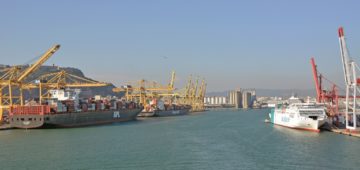



Comments
Sorry, comments are closed for this item